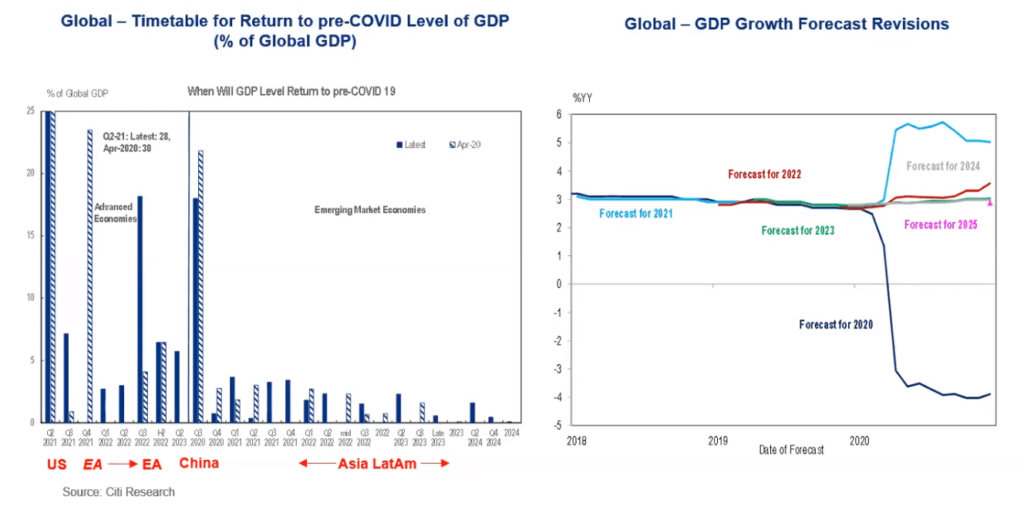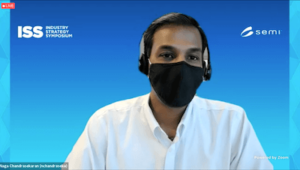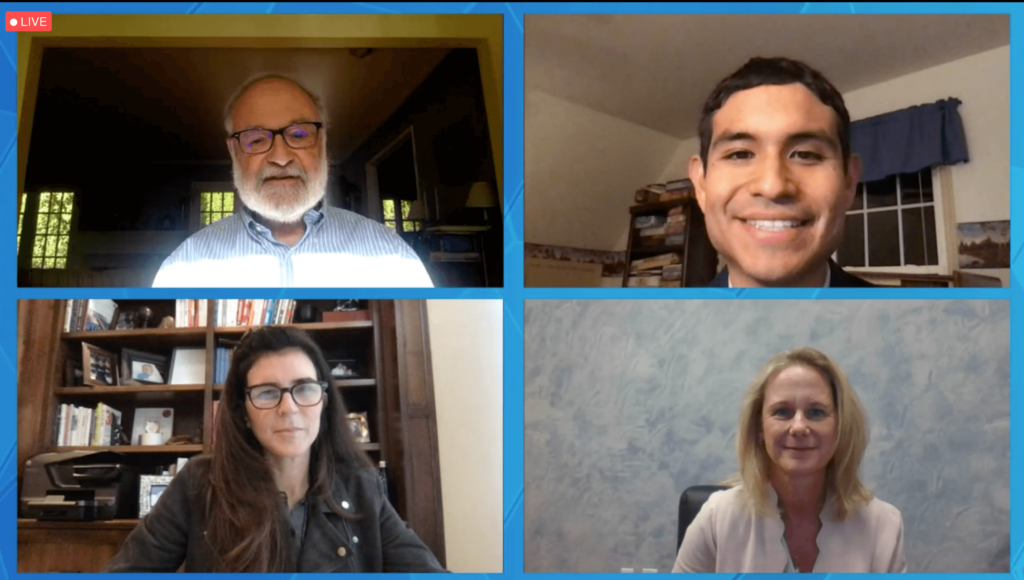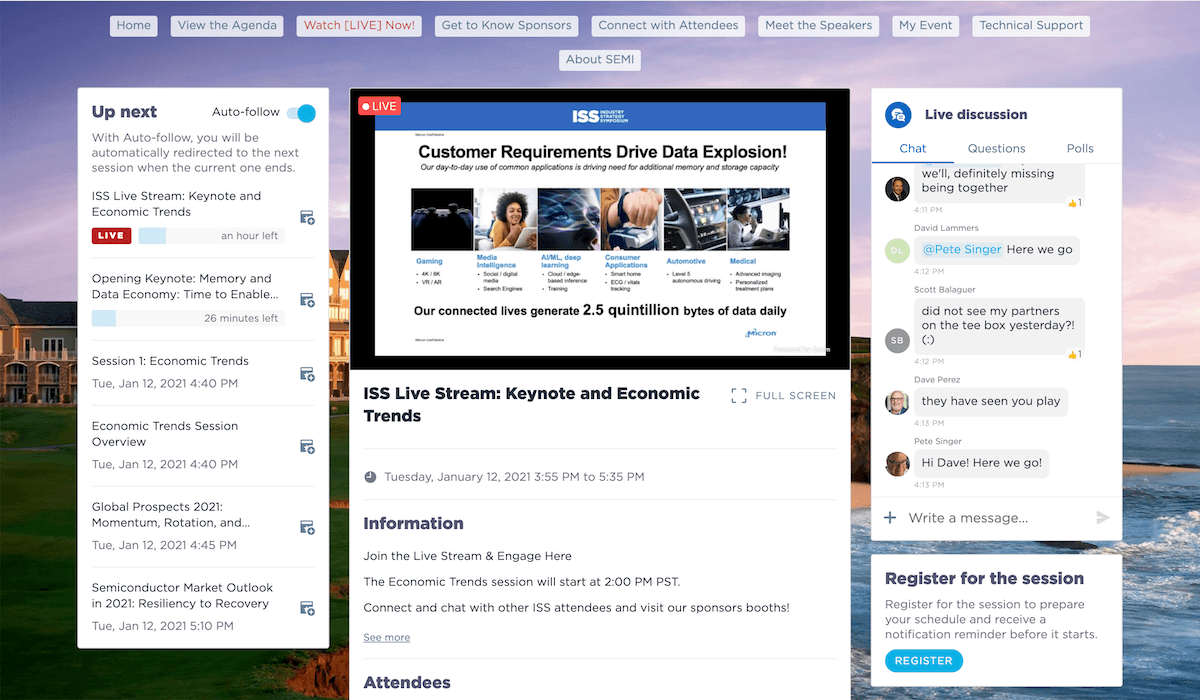Two weeks into the new year and the virtual industry events are off and running. Hot topics included the global economic trends, the status of the semiconductor markets, the impact of the data economy, the geopolitical climate with a focus on China, and the importance of diversity, equity, and inclusion in the workplace. Here’s what I gleaned from the speakers at SEMI’s Industry Strategy Symposium (ISS), Meptec’s Speaker Series featuring Jan Vardaman’s 2021 Outlook, and a SEMI webinar: Developing a Diverse Workforce – Status and Change.
The Global Economy
At ISS, Catherine Mann, global chief economist at Citibank, painted a cautiously optimistic, yet very fragile, picture of the global economy from the demand side. She said that while prospects are aligned for positive global growth of 5%, this is actually a downward revision of the last ten months. She warned us to think of it less as recovery and more as a rebounding economy.
While China is already back to a pre-COVID level of GDP, the US isn’t expected to reach that until Q2 of 2021. For Europe, it may not happen until Q4 2021, or even early 2022 (Figure 1). Mann said we won’t see a robust return to the services trades – leisure and hospitality – until “we get a vaccine.” She also noted that gains in automotive markets were lost elsewhere.

The Semiconductor Markets
Analysts are in agreement that the semiconductor industry is in a growth cycle, fueled by the ever-expanding data economy. 2020 growth was greater than expected, as a consequence of the increased need for digital connectivity due to COVID 19. (In his ISS 2020 talk VSLI Research analyst, Andrea Lati actually referred to it as the COVID Boom – which I find in particularly poor taste. Sensitivity training might be in order?)
Mario Morales, of IDC, said slow, steady growth over the next five years will bring the industry to the $500B mark. But he also cautioned us to monitor consumer behavior closely. He thinks investments will continue, but the decision-making process will take longer. He reiterated that the semiconductor industry is important and “a critical backbone for recovery.”
As Jan Vardaman noted in her Meptec talk, one thing that could impact growth is the health of the semiconductor supply chain. For instance, while the automotive industry rebounded faster than expected, a chip shortage is now slowing that recovery. In fact, earlier this week (January 18) Audi furloughed 10K workers because of the shortage and delayed the production of some of its cars.
Vardaman zeroed in specifically on increasing demand for laminate substrates, driven by data center and cloud computing expansion. On top of that, fire damage to the Unimicron substrate facility in Taiwan is making the tight substrate capacity worse. The overarching problem, of course, is the profit margin. Advanced substrates for IC packaging are expensive, and lead times are long, she explained. There is no incentive to increase capacity. She noted that leadframe suppliers are exiting the market, chip capacitor companies are not adding capacity, and 200mm wafers are an ongoing concern. Vardaman said we need a new business model for IC package substrates to give suppliers the incentive to invest in next-generation production. This is such an important call to action, that we featured the full presentation in our Video of the Week.
Putting Machine Learning to Work for Us
 In his ISS keynote talk, Naga Chandrasekaran. SVP, Technology Development Micron Technology, Inc. talked about the increasing demand for high-bandwidth memory (HBM) products needed to support the new era of machine learning (ML) These applications require faster algorithms and processing speed, that only HBM can provide. He said to meet these needs, the semiconductor industry needs to put the very ML technologies we helped develop to work for us.
In his ISS keynote talk, Naga Chandrasekaran. SVP, Technology Development Micron Technology, Inc. talked about the increasing demand for high-bandwidth memory (HBM) products needed to support the new era of machine learning (ML) These applications require faster algorithms and processing speed, that only HBM can provide. He said to meet these needs, the semiconductor industry needs to put the very ML technologies we helped develop to work for us.
Integrating ML and the internet of things (IoT) into advanced fab equipment will help improve the speed of technology development and deliver yield maturity at a faster rate, he explained. For example, by integrating sensors into a process tool, we can predict wafer defects or wafer performance. From the data gathered, we can build algorithms to improve process conditions.
This concept is in its early stages because there is not enough data gathered in an R&D environment to implement ML solutions. However, ML is proliferating in the design space, noted Chandrasekaran. To make this possible, he said we need to work collectively and be willing to share best practices in artificial intelligence (AI) and ML with our industry partners.
The Geopolitical Situation
Martijn Rasser of the Center for a New American Security opened up a proverbial can of worms with his ISS talk, Rethinking Export Controls: Unintended Consequences and the New Technology Landscape.
Essentially, Rasser expressed concern that the US no longer dominates the technology landscape, and that China is poised to become the next leader in this area, because of its Made in China 2025 initiative. He suggested that the US government should change its strategy, and rather than posing restrictions on chip sales to China, we should sell them all the chips they want, but that we should restrict equipment sales to slow China’s advanced technology development progress. Rasser suggests this will involve proposed incentives to US equipment manufactures, and also are hoping to encourage US Allies to do the same.
Clearly, this does not align with SEMI’s agenda, which, as an international organization is to support a symbiotic relationship between the US and China. In fact, when Ajit Manocha spoke at SEMICON Europa 2017, and again at SEMICON West in 2019, about China’s growth efforts, and the US-China Trade War, he reminded us that it was a US/China issue that didn’t involve other countries and that SEMI’s goal as an organization is to grow the entire industry.
I also know from conversations with European equipment suppliers after US sanctions were imposed that some of them benefited from US sanctions in 2019 – because as long as their tools contained less than a certain percentage of components built in the U.S., they were free to sell to China. Some of those companies did rather well.
Pasetti confirmed my thoughts on this saying, “We think there are significant inconsistencies and likely unintended consequences of such a policy.” I’m looking forward to digging deeper into this with him. Stay tuned.
Diversity, Equity, and Inclusion
This is another topic you’ll be hearing lots more about this year on 3D InCites. I attended two SEMI-sponsored events on this topic in the past week. The first was the ISS Panel, What is the Role of Diversity and Inclusion in Innovation, and the second was a free webinar, Developing a Diverse Workforce, Status, and Change.
ISS panelists discussed the distinction between inherent (what you’re born with) and acquired (what life experiences give you) diversity, and how both are important to create an innovative workforce. The reinforced the notion that an inclusive environment generates more creative ideas to fuel innovation. It changes how people think and approach problems.

Pedro David Espinoza, of Pan Peru USA, offered leaders these tips on how to help foster innovation:
- Reward failure: allow employees to “fail forward” because we often learn more from our mistakes than we do from our successes
- Follow the lead of tech start-ups by establishing a flat corporate structure versus a hierarchy
- Create a culture of belonging, where employees can bring their entire selves to work
When it comes to building a board of directors, it’s important to not just make sure you’re checking a box, but really valuing what that person brings to the table. But to even accomplish that means changing the requirements for serving on a BOD, making them more skills and experience-based, than having previously served on boards or being a C-suite executive.
As its title implied, the hour-long webinar focused more on women in the workplace, versus under-represented minorities. Findings from the 2020 McKinsey report were shared, as well as success stories from Lam Research and FormFactor. Both companies have developed robust DEI programs and serve as great examples for other companies looking to embark on a DEI journey.
The only drawback to these events was that based on the attendees, it seemed the speakers were mostly preaching to the choir. Those who really need to understand this information are not those most likely to attend. If you fall into that category, then I urge you to take the time and view the recordings of both that are still available on-demand:
Virtual Event Scorecard
Lastly, no post about events would be complete without a virtual event scorecard. Even under the best of circumstances, these events still have a hard time measuring up to their in-person, pre-COVID predecessors. And no matter how valiant the effort, there was no way that Virtual ISS could replace the real thing. But SEMI organizers knew that going in. Those fortunate enough to have attended previous editions at the Ritz Carleton in Half Moon Bay knew very well what we were missing. Banter in the chatbox was about the weather in Half Moon Bay (57 degrees) and golf: “I didn’t see my partners on the tee box yesterday!”
Personally, I was relieved that SEMI recognized the sensory overload we’re all getting from full days of online sessions. The pared-down version of ISS took place over two afternoons and included a networking break to give attendees time to network with other attendees via the chatbox, video chat, and a Trivia Game (which I unfortunately missed), but I heard it was fun.
Wrapping it Up
If you made it to the end of this blog post, congratulations! There’s a lot packed in here. But we barely scratched the surface of these important topics. Consider this a preview to some more in-depth conversations on these areas as 2021 unfolds. ~ FvT



















